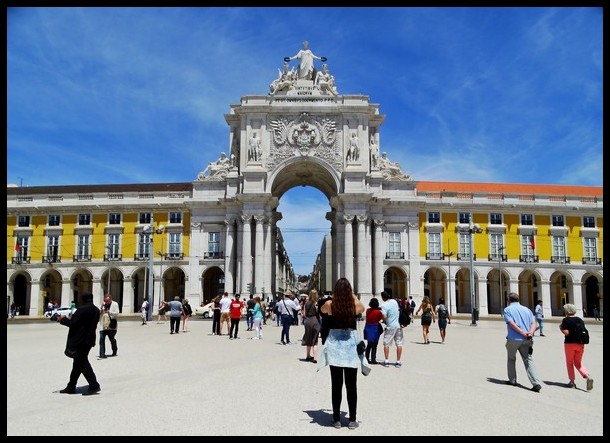
Arch da Rua Augusta – LIsbon
I just spent two weeks in Lisbon!
Surprise – I’m just finishing a wonderful two-week visit to Lisbon, Portugal! At least it’s a surprise to me…
Back in January, when I planned my travel itinerary for 2019, it had never even crossed my mind to visit Portugal this year. I planned to start the year exploring Morocco then the far-flung Canary Islands and then head to Barcelona, Spain (All of which I’ve already done).
I also planned to head to Montenegro in mid-June and from there explore the other Balkan countries for the rest of the year (still on target for that). I had a 2-4 week gap between Barcelona and Montenegro that I hadn’t made concrete plans for, though I intended to go explore Italy, primarily because it’s the closest European country to Montenegro. From Italy I could take a ferry across the Adriatic Sea.
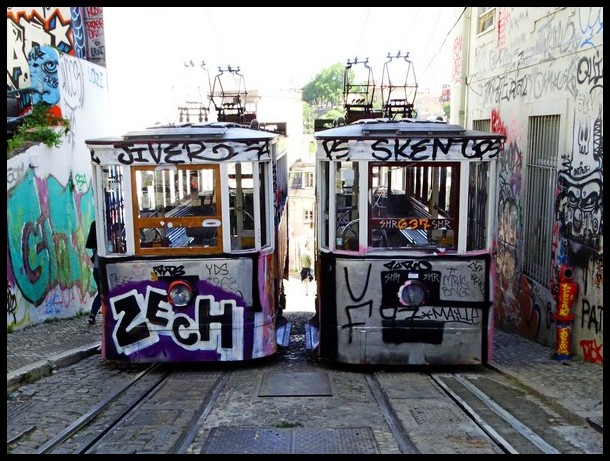 How I Ended up in Lisbon
How I Ended up in Lisbon
But I recently ran into a glitch with my Barcelona and Italy plans. While I was finishing up my time in Canary Islands, I finally began looking ahead to the next legs of my travels.
I quickly began realizing that booking accommodation anywhere in Europe at the ‘last minute’ was not too easy, especially if looking for budget accommodation, and especially in summer months. I was having a heck of a time finding anything reasonably priced in Barcelona or anywhere in Italy.
I started chatting with other travel friends in Europe and one of them invited me to stay with him in Lisbon for two weeks after my visit to Barcelona. So I thought, what the heck, I’m up for a change of plans.
Given the difficulty of finding accommodation anywhere in Italy, and the added problems coordinating flights, I decided to jump on his offer. It really seemed like one of those ‘meant to happen’ things.
Within hours of his invitation, I had booked my flights to/from Barcelona, Lisbon and Montenegro. I discovered that it was inexpensive and easy to fly to Lisbon from Barcelona, as well as from many other cities in Europe and North America. It was equally easy to fly out of Lisbon to just about anywhere.

LIsbon pastries
Arrival in Lisbon
Not long after that, and after two weeks exploring fabulous Barcelona, I hopped on my 1.5 hour flight over to Lisbon and landed in my friend’s nice, cozy apartment in a lovely, quiet neighborhood of the city center.
To be completely honest, I was actually visiting a friend of a friend. We’d never actually met before, though we’d both heard a lot about each other from our mutual friend. So it was great to make a new friend one who also loves traveling.
My new buddy’s name is Ran. He proved to be a really nice guy and generous host. He made me feel really welcome and right at home (Thanks Ran!).
He also set about introducing me to Lisbon. He showed me around his neighborhood my first day in town, then the city at large the following day. He also gave me many recommendations on places to see, things to do, and local foods to sample.
As it turns out, Ran is half Portuguese and spent childhood summers in Lisbon, so he also had a lot to teach me about Portuguese history and culture. Bonus!
I also had done my own research before arriving, as usual, so had a whole list of things I wanted to see and do. My list coincided pretty well with what Ran recommended.
After Ran’s initial ‘guided tours’, I went out to explore the city quite extensively on my own just about every day for two weeks. Through all of that, I’ve learned a lot about Lisbon during my two week stay. To start with…
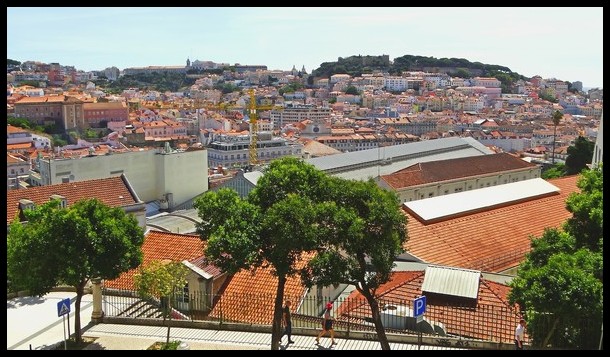
Lisbon panorama
Introduction to Lisbon
Lisbon is Portugal’s capital city and has a very long, complex history. At one point, it was one of the most glamorous and cosmopolitan cities in Europe. The entire city center is still filled with gorgeous historic buildings, with a variety of architectural styles, as the city developed over a period of more than 1000 years. Portuguese call it Lisboa.
The city is set along the banks of broad Rio Tejo (Tejo River) just a stone’s throw inland from where the river empties into the Atlantic Ocean. So Lisbon is practically a coastal city, with the nearest beaches located only 20-30 minutes from the historic center.
One of the main distinguishing features of Lisbon is that it’s extremely hilly. Aside from a narrow flat strip along the river, the city is completely filled with very steep, rather narrow cobblestone streets that wind and curve around the contours of the land. The steep hills make walking around Lisbon a fairly athletic pursuit. Just getting around the rather compact city is a great way to stay fit.
Lisbon also has many other very distinctive – and renowned – features. Aside from its steep hills, probably the three most famous features of Lisbon include its cobblestone streets and sidewalks, the grand historic buildings covered in vibrantly-patterned ceramic tiles, and the vintage tram cars that run along tracks up and down the streets.
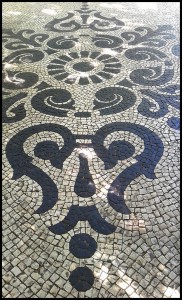 Lisbon’s Cobblestone Roads and Sidewalks
Lisbon’s Cobblestone Roads and Sidewalks
I’ve visited many cities and towns in the world that still have cobblestone roads. But Lisbon’s stones are different from any I’ve seen elsewhere. They are all small square flat stones, either white or black. Compared to other types of cobblestone I’ve seen, Lisbon’s roads are still relatively flat, whereas in other places the stones tend have become rather rounded, worn over time, making the streets incredibly uneven.
Lisbon’s Famous Black & White Stone Sidewalks
On the other hand, I don’t recall seeing cobblestone sidewalks anywhere else in the world.
The most famous aspect of Lisbon’s cobblestone sidewalks are the beautiful black and white patterned sidewalks found along several of the city’s grandest avenues and plazas. I’d read about them beforehand. But I was surprised to discover the sheer variety of patterns that grace the historic district.
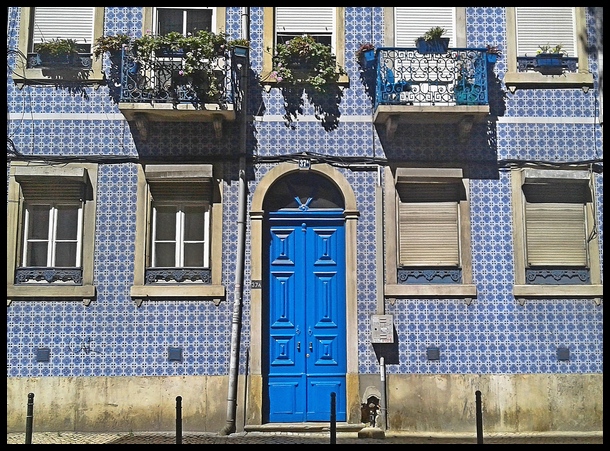 Lisbon’s Famous Patterned Tiles
Lisbon’s Famous Patterned Tiles
Lisbon’s colorful, intricately-patterned tiles are famous around Europe. They are especially unusual because they grace the exteriors of many grand buildings. In most other places, tiles are used for interior floors or walls. In Lisbon every building seems to have its very own unique tile patterns.
Since I just spent two months traveling around Morocco, I had become accustomed to such colorful patterned tile-work. However, in Morocco, the exterior of buildings are absolutely plain and dull – just squar-ish buildings of simple terracotta-colored plaster walls. Period. But the interiors are a completely different matter. Inside, vibrant tiles cover floors, walls, sometimes even pillars or ceilings.
In Lisbon, they’ve put the colorful ceramic displays outside.
The patterns and colors used on most Lisbon tiles are very different from those in Morocco. During two weeks exploring Lisbon, I’ve only seen one or two buildings with Moroccan patterned tiles.
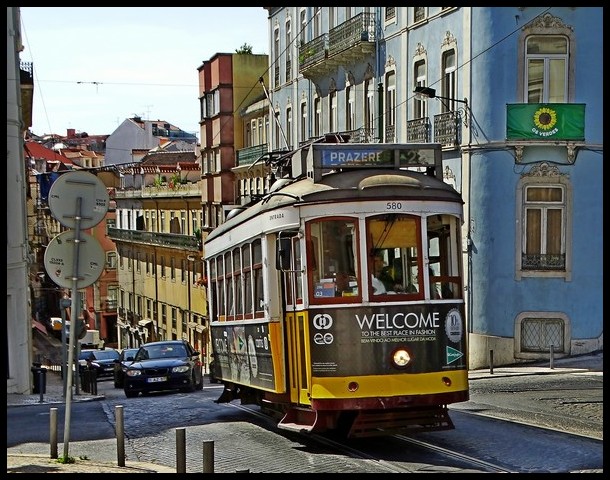 Lisbon’s Famous Trams
Lisbon’s Famous Trams
Lisbon’s historic trams are absolutely adorable! The tiny cars are either yellow or red with beautiful vintage wood interiors and electric cables connecting them to an overhead cable system.
Riding a Lisbon vintage tram is generally a rather jolting experience as the cars clank along the tracks, weave up and down steep hills and curve around bends, while the conductor is continually adjusting the steering, gears and brakes.
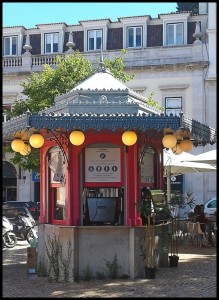 Other Lisbon Charms
Other Lisbon Charms
There are several other distinctive features I’ve come across in Lisbon, too.
There are the cute little wooden gazebos found in most parks and plazas. Nowadays the kiosks sell food and drinks. Then there are the hundreds of little local restaurants, bakeries and cafes that seem to line nearly every street in the city.
Then there’s Lisbon’s high, red suspension bridge that’s nearly the same as San Francisco’s Golden Gate Bridge. Not too surprisingly, Lisbon’s bridge was designed by the same engineer!
As for historic architecture, besides thousands of historic government buildings, houses and stores, there’s famous St George Castle perched on top of Lisbon’s highest hill, the massive Jeronimos Monastery and several elaborate palaces. Several excellent museums are also scattered around the city.
Lisbon also has some iconic modern buildings like MAAT ( Museum of Art, Architecture and Technology).
Summary of my Two-Week Visit to Lisbon
Needless to say, I think Lisbon is an utterly charming city, full of open cobblestone plazas, beautiful leafy green parks, gorgeous historic architecture, cute little wooden park kiosks, adorable vintage tram cars, a ka-zillion local restaurants & cafes, and many spectacular viewpoints over the city, due to the abundant hills.
I’ve really enjoyed exploring for two weeks. And I count myself lucky to have had the opportunity to visit, especially considering my tight budget. I’ll be ever indebted to my new friend, Ran, for hosting me these two weeks.
Thanks heaps, Ran! You’re awesome!
You might also like:











 Hi! I'm Lash, an American nomadic world traveler who's been traveling solo since 1998. I’m passionate about traveling the world nomadically and then sharing it all with you. I hope to inspire you to travel the world, to entertain you with tales from the road, and to help you reach your travel dreams. Welcome!
Hi! I'm Lash, an American nomadic world traveler who's been traveling solo since 1998. I’m passionate about traveling the world nomadically and then sharing it all with you. I hope to inspire you to travel the world, to entertain you with tales from the road, and to help you reach your travel dreams. Welcome! 




1 ping
Introduction to Montenegro
2019/06/19 at 11:48 pm (UTC 8) Link to this comment
[…] Lisbon, Portugal […]